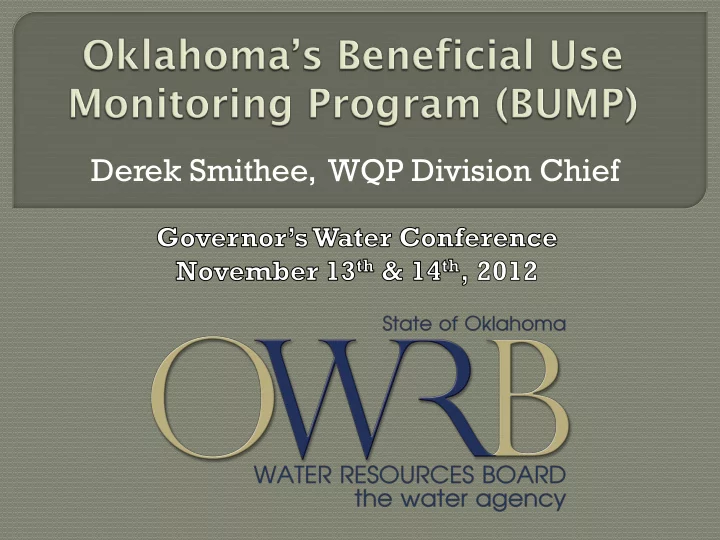

Derek Smithee, WQP Division Chief
Decisions don’t require data But GOOD decisions do! Quality Quality Quality + = Data Interpretation Management
Beneficial Use Monitoring Program (BUMP) Initiated in 1998. Physical, chemical and biological data collected from Oklahoma’s streams and lakes is used to: Support development of Water Quality Standards. Prioritize pollution control activities. Specific Objectives Include : Long-term water quality trends. Document impairments to beneficial use (and identify sources) 303(d) & 305(b). Identify pollution problems before they become a crisis.
Probabilistic Based Monitoring Program Lakes greater than 500 surface acres in size • Sampling conducted four times annually to represent seasonal variation Each lake sampled two years of every five Lakes greater than 50 surface acres but less than • 500 Lakes drawn from a randomized list, to ensure equal probability of being selected Different lakes sampled annually Broad based parametric coverage Traditional chemistry and water column profiles • Metals, bacteria, Phyto- and Zooplankton • information collected Habitat monitoring •
Streams/Rivers • 96 fixed river and streams sites sampled Bi-monthly (6 times annually) • 100 probabilistic stations sampled once during a four year period • Fish collection made on fixed sites once every 5 years and once at each probabilistic site. • Winter and summer macro- invertebrate collections made once every 2 years at fixed sites and once at each probabilistic site.
Streams/Rivers • 14 sites operated by the OWRB with real-time river stage gages and an additional 12 sites that are measured for river discharge during site visits. All OWRB gauged sites require base flow monitoring as well as targeted high flow monitoring • USGS Co-operative program 65 river gages operated by the USGS at a cost of $691,100 21 of those river gages are funded by BUMP at a cost of $115,000
Five years in development including technical & public input meetings to establish a Water Plan to 2060. Adoption by the Oklahoma Legislature in February 2012. The OCWP recommended $2,235,000 in new annual funding for water quality and water quantity Monitoring.
The State Legislature should provide a dedicated source of funding to enable the State of Oklahoma to accurately assess the quality and quantity of its water resources, thereby ensuring improved water quality protection, accurate appropriation and allocation, and long-term collection of data to make informed water management decisions. Such funding should be directed toward development and maintenance of a permanent statewide water quality and quantity monitoring program(s), specifically allowing for the following: • Integration of all state surface and groundwater quality monitoring programs into one holistic, coordinated effort. • Stable and dedicated appropriations for critical statewide monitoring programs, such as Oklahoma’s Cooperative Stream Gaging Program, Beneficial Use Monitoring Program, and Nonpoint Source Monitoring Program, as well as other agency efforts to monitor point source, agriculture, mining, and oil and gas impacts. • Creation of an ambient groundwater quality monitoring program. • Full implementation of a statewide program for the collection of biological data to provide a better indication of long-term water quality trends in Oklahoma.
Overall Objective: More closely align surface water sampling with OCWP and collect more robust dataset to aid assessment and decision making • Adjust spatial coverage to align with the OCWP planning basins Goal is to have a station at the terminal end of all the planning basins Maintain a set of reference stations across the state • Adjust temporal coverage to 8 visits annually (once every 6 weeks) at most of the sites
Coordinate with Oklahoma Conservation Commission, Oklahoma Scenic Rivers Commission, United States Geological Survey, etc. to minimize work overlap Increase parametric coverage across the state Install additional 10 real-time river stage gages Assure adequate flow gage coverage across the state
Change temporal coverage from 4 visits per year to 6 per year Increase parametric coverage at sample lakes to collect additional critical data Pursue conducting Nutrient-Limited Watershed (NLW) studies to document presence or absence of impairment
Primary Objectives:
Ogallala Aquifer Blaine Aquifer Blaine Aquifer
Year 1 200 WQ 300 WL Year 2 185 WQ 270 WL Year 3 190 WQ 305 WL Year 4 160 WQ 225 WL
Create a state of the art Water Quality and Quantity Data Management Network Multi-functional with a variety of user interfaces Comprehensive • Waterbody/Aquifer Types • Geospatially Integrated • Multiple Data Types (e.g., chemistry, physical, biological, toxicological, real-time) • Variety of Applications (Analytical and Reporting Formats)
Internal Network Development Meetings (concluded November 2012) Phase 1 – Network Development • Targeted Completion Date: April 2013 Phase 2 – Network Implementation and Data Migration • Targeted Completion Date: October 2013 Phase 3 – Advanced Application Development • Targeted Completion Date: June 2014
Derek Smithee, WQP Division Chief 405.530.8800 drsmithee@owrb.ok.gov
Recommend
More recommend